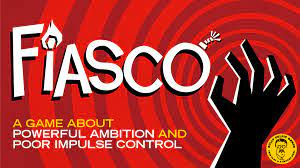Fiasco taught me an invaluable lesson on the role of roleplay in tabletop roleplaying games. I have learned more about theater in this one course than I have in my whole life, and it really did begin with our tabletop roleplaying game sprint. Bringing theater into gameplay in more constructive, guided ways—like in Fiasco.
The setup is as complex as one would expect, and so too are the mechanics of Fiasco. The game revolves around a series of scenes, each of which is driven by the players’ actions and decisions. The scenes are structured in a way that encourages players to improvise and develop the story organically, leading to unpredictable results. For example, in the session I played, there was a 55-gallon barrel of urine at the center of our scenario’s crime. The human imagination is a terrible thing sometimes.
The playsets presented in Fiasco are a collection of scenarios and characters that provide the framework for each game. The sets are sem-detailed and varied, ranging from gritty crime dramas to absurd comedies, and offer inroads to creative storytelling and narrative improvisation. Something that I did not explore thoroughly with my group but would want to in future sessions were the “Tilt” and “Aftermath” tables. The tables add an element of randomness to each game and can lead to unexpected twists and turns in the story. There are small hints throughout the book for those who might be stuck on how to move the game forward. Regardless of level of experience, the real-time factor of tabletop roleplaying games requires energy and attentiveness on order for the experience to be enjoyed by all.
While I found the overall tone, scenarios, and examples to be unsavory (i.e. centered around revenge and sexual relations), I appreciated that an entire book was dedicated to the setup of a game. This also gave those of us who played the opportunity to not just understand what world building is, but how world building is emergent when given the proper tools and setup. My main critique is that the game feels culturally relevant to western audiences, but I cannot say the same for audiences outside of western markets. It requires players to build characters of morally ambiguous backgrounds, explore their flawed motivations and desires, and develop relationships with other players via their characters.
Overall, Fiasco is a neatly packaged example of a tabletop roleplaying game. The scenarios did not inspire me as much as they did others, but the core mechanics are learnable. That steep learning curve was felt, though—almost two hours of setup for an hour of gameplay felt like a slog, but that might also be due to the number of novices on our team (including myself). This one’s for players who have a darker sense of humor and enjoy improvisation. The game encourages players to take risks and explore their creativity, making each playthrough a unique experience.
